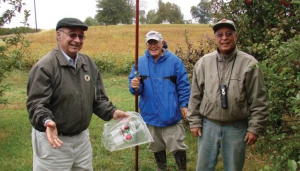
Midwest Apple Improvement Association founders Ed Fackler (left) and Mitch Lynd (right) met in Jim Eckert’s MAIA planting to help with apple evaluation, a process that has members tasting thousands of fruit each fall.
Photo courtesy of Diane Doud Miller
The new apple looks a lot like a Fuji, is sweet like a Fuji, matures late like a Fuji, and keeps like a Fuji. But it does not crop like a Fuji, and that’s good news.
“In our region, Fuji is all tree and no apples,” Lynd said in a conversation with Good Fruit Grower. “Here, 350 bushels per acre is the maximum we can get with Fuji if we are to get return bloom. EverCrisp will make growers more money than Fuji ever did. There’ll be no reason to grow Fuji ever again.”
Lynd, now 70 and retired both from the Lynd family’s fruit farm at Pataskala, Ohio, and from the Midwest Apple Improvement Association that he is credited with cofounding 15 years ago, sounds pretty negative on Fuji—considering he was one who chose it as a parent for EverCrisp, mating it with Honeycrisp.
“The cross made sense to us,” he said.
Fuji is a wonderful apple that “keeps like rocks,” he said, but it is unproductive. Fuji, as a parent, also offered the potential for late blooming, a trait that was foremost in the minds of lower Midwest growers when they organized MAIA. One of Fuji’s parents is Ralls Janet, a late-blooming apple that is called Never Fails where it’s grown in Virginia, Lynd said.
“We grow in an area with zero maritime influence,” Lynd said. “Our family here has enjoyed a wonderful income from apple growing since the 1860s, but we’ve had to live with crop failures because of late spring freezes. What Michigan and New York experienced this year, we can expect one year in five.
“Rome Beauty has been one of our anchor varieties, not because it’s a great apple, but because it’s late-blooming and therefore a reliable cropper.”
Of course, the choice of Honeycrisp as the other EverCrisp parent was easy to make because of its great texture and crunch. “Fuji can be chewy, and that’s hugely different than crispy,” Lynd said.
Honeycrisp also blooms somewhat later, and it is somewhat disease resistant, Lynd said. While it does not carry the Vf apple scab resistance gene that was bred into apples in the PRI breeding program, there are other “complicated” sources of disease resistance, and Honeycrisp has some of that, Lynd said.
While the new variety has not been observed for very long and was only selected for elite treatment in 2008, indications so far are that it’s an annual cropper, Lynd said. Despite being grown on its own root, the mother tree is naturally precocious, he said. Growers will have to manage young trees so they don’t overcrop early and runt out.
“I should also mention that I spoke with David Doud yesterday and, much to my surprise, he told me he never thinned the original EverCrisp tree,” Lynd said. “It had four heavy crops in a row, and the apples were always perfectly spaced. I was shocked. The crop load always looked so perfect, I just assumed it was hand thinned.
MAIA is also evaluating other Honeycrisp-Fuji crosses. “The one I like best has a maturity date that is the same as Honeycrisp,” he said. “That is not the apple to introduce right now, with Honeycrisp having momentum like no other apple ever. We don’t need a competing apple in that season.”
Lynd believes the Midwest Apple Improvement Association will establish its reputation based on EverCrisp—but will go on to find lots of other good apples. He gives two reasons.
First, the members who participate in the breeding and evaluation are farm marketers who meet the public face to face. U-pick customers at Lynd Fruit Farm are invited to taste any of the apples that are ripe that week and then fill their baskets with those they like. Given that opportunity, they choose taste. “We are driven by taste, not appearance,” he said.
Second, formal taste tests reveal that not all people like the same things. Apples that rate a 10 by one person may rate 0 with another. Supermarkets tend to settle for an apple that rates a 5 with everybody, but that’s no reason to deprive apple lovers of those 10s they’d like to have. But these apples have been thrown away in conventional breeding programs.
There is a lot of room at farm markets for niche apples.
Breeders like Dr. Susan Brown at Cornell University, Dr. David Bedford at University of Minnesota, Dr. Jules Janick at Purdue University, Dr. Joseph Goffreda at Rutgers University, and Dr. Diane Miller at Ohio State University have shown great willingness to teach and help the MAIA grower/breeders understand apple genetics and breeding.
Ed Fackler, the person who worked with Lynd in cofounding the Midwest Apple Improvement Association, is still a member. A former nurseryman and apple grower, he is now associated with a mail order nursery company, Gardens Alive, in Lawrenceburg, Indiana.
EverCrisp agreement
Producers wanting to grow EverCrisp must sign an agreement with the following stipulations:
• They must join or be members in good standing of the Midwest Apple Improvement Association and pay annual dues, currently $100 per year;
• They must use only the name EverCrisp and its trademark and logo and not use any other names or trademarks in selling this variety.
• They must not register or otherwise seek to develop any EverCrisp sports or mutations, which become the property of MAIA.
The agreement is in effect for 20 years after date of tree delivery. Annual fees are due January 1 for years 4 through 20. Fees begin in 2019 and are 20 cents per tree per year through 2025 and 30 cents per tree in 2026 through 2035. —R. Lehnert

Leave A Comment